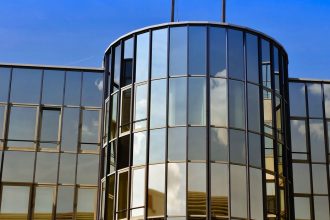As global awareness of climate change escalates, the construction and real estate sectors are increasingly recognizing the importance of energy-efficient architecture and sustainable development practices. With pressure mounting from both consumers and regulatory bodies to minimize carbon footprints, innovations in green building design have become more critical than ever. This post explores the rise of energy-efficient architecture, highlighting innovative practices, notable initiatives like the Living Building Challenge, and the future of sustainable real estate development.
Understanding Energy-Efficient Architecture
Energy-efficient architecture involves designing buildings that minimize energy consumption while promoting functionality as well as occupant comfort. It incorporates foundational principles from sustainable architecture, aiming to create structures that not only reduce energy usage but also positively impact the environment. The focus is on designing buildings that harmoniously blend with their surroundings, utilize renewable energy sources, and enhance the quality of life for their inhabitants.
Key Components of Energy-Efficient Architecture:
-
Passive Design: This involves harnessing natural resources such as sunlight and wind to regulate temperature and lighting. Techniques include strategic building orientation, the use of thermal mass, and high-performance insulation.
-
Renewable Energy Integration: Incorporating solar panels, wind turbines, and geothermal systems helps reduce reliance on fossil fuels and promotes energy independence.
-
Water Conservation: Sustainable buildings employ rainwater harvesting systems, greywater recycling, and efficient plumbing fixtures to reduce water consumption.
-
Sustainable Materials: Use of recycled, locally-sourced, and environmentally-friendly materials minimizes the ecological impact of construction.
- Indoor Environmental Quality: Proven practices include maximizing natural light, using non-toxic materials, and ensuring good indoor air quality, all of which contribute to the health and well-being of occupants.
Innovative Practices in Green Building Design
Numerous innovative practices are emerging in the realm of green building design as architects, engineers, and developers step up their commitment to sustainable development.
1. Biophilic Design
Biophilic design seeks to strengthen the connection between people and nature. By incorporating natural elements—such as living walls, indoor gardens, and natural light—into architectural plans, buildings promote well-being and reduce stress levels among occupants. This trend is gaining traction as studies demonstrate the benefits of nature on mental health and productivity.
2. Smart Building Technologies
The integration of IoT (Internet of Things) technologies enables real-time energy monitoring and management. Smart thermostats, energy-efficient lighting systems, and automated shading can significantly reduce energy consumption while enhancing comfort.
3. Modular and Prefabricated Construction
This method reduces waste and allows for greater control over energy efficiency through streamlined manufacturing processes. Modular units are designed with energy-efficient standards in mind and can be assembled on-site more quickly than traditional building methods.
4. Carbon Neutral Buildings
The push towards zero-net energy (ZNE) and carbon-neutral buildings is gaining momentum. These structures produce as much energy as they consume over a year through renewable resources and energy efficiency measures.
The Living Building Challenge
An exemplary initiative that exemplifies the gold standard in sustainable design is the Living Building Challenge (LBC). Launched in 2006 by the International Living Future Institute, the LBC is a rigorous performance-based certification program for buildings that strive to be self-sufficient and have a positive impact on their surroundings.
Key Features of the Living Building Challenge:
- Place: Encourages projects to respond to their environment, preserving, restoring, or enhancing the ecosystem.
- Energy: Buildings must generate more energy than they consume through on-site renewable energy sources.
- Water: Aims for water neutrality, with buildings capturing and treating all water on site.
- Materials: Emphasizes the use of safe, non-toxic materials, supporting a healthy indoor environment.
- Equity: Promotes social equity, emphasizing inclusivity and community engagement in the planning process.
The LBC has been pivotal in showcasing what is achievable in green building design. Noteworthy buildings certified under this initiative include the Bullitt Center in Seattle and the Bosco Verticale (Vertical Forest) in Milan, which exhibits an innovative approach to integrating green spaces within urban settings.
The Future of Sustainable Real Estate Development
With consumers becoming increasingly conscientious about environmental issues, developers are under pressure to create buildings that not only meet market demand but also address climate change.
Regulations and Incentives
Governments worldwide are imposing stricter regulations on energy efficiency and green building practices, paired with incentives to encourage compliance. Tax credits, grants, and subsidies for sustainable initiatives drive growth in the energy-efficient sector.
Market Shift
As interest in sustainability continues to rise, the market for green buildings is expanding. Studies by organizations like the World Green Building Council indicate that energy-efficient buildings often command higher rents, experience lower vacancy rates, and increase property value over time.
Community Engagement
Future sustainable development will likely prioritize community engagement, ensuring that projects meet the needs of local populations and contribute to the social and economic fabric of the area.
Conclusion
The rise of energy-efficient architecture and sustainable real estate development marks a significant shift in how we approach the design and construction of buildings. Through innovative practices and initiatives like the Living Building Challenge, the industry is making strides toward creating spaces that are harmonized with the environment, enhance occupants’ well-being, and contribute positively to the community. As we look to the future, the integration of smart technologies and a commitment to sustainability will continue to drive the evolution of architecture toward a greener, more sustainable world.
In a rapidly changing landscape, the construction sector stands at a crossroads; adopting smarter, innovative practices today paves the way for a sustainable tomorrow.







